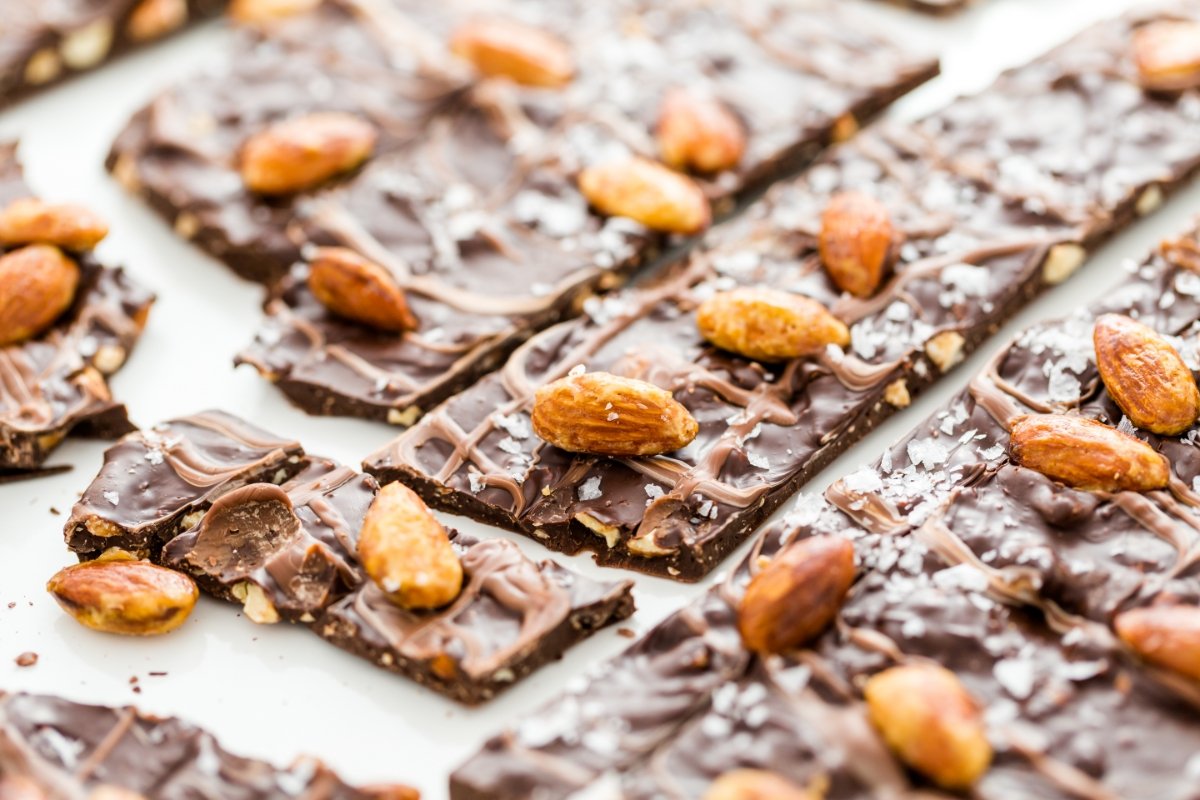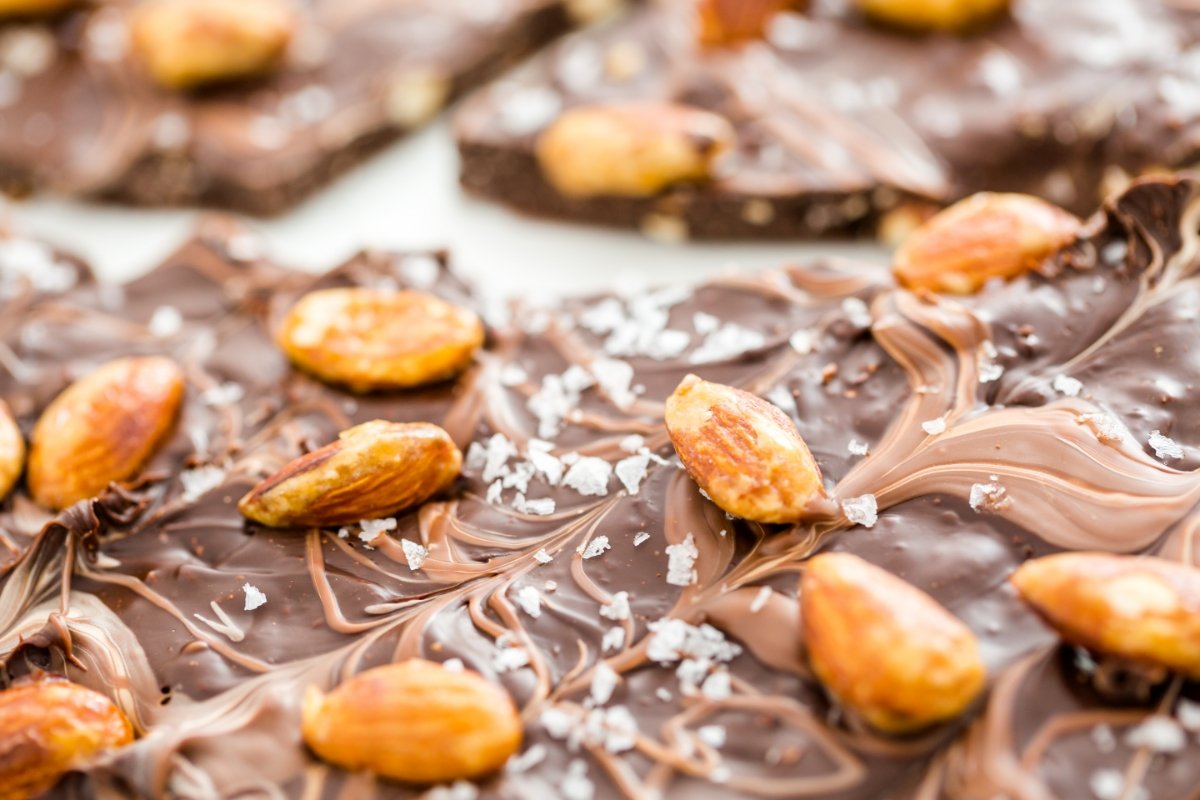Almond bark, a delectable treat combining the rich, creamy texture of chocolate with the crunchy nuttiness of almonds, stands as a testament to the timeless allure of simple yet sophisticated confections. This treat not only delights the palate but also offers a canvas for culinary creativity, making it a cherished ingredient in the confectionery arts. Whether it’s the holiday season or a simple craving for something sweet and satisfying, almond bark offers a perfect blend of texture, taste, and indulgence.

As we delve into the world of almond bark, we’ll explore its origins, how it’s made, and the various ways it can be customized and enjoyed. From its humble beginnings to its rise as a gourmet delight, it exemplifies how a few basic ingredients can be transformed into a multitude of exquisite treats. This blog aims to guide enthusiasts from the initial steps of selecting quality ingredients to mastering the art of creating the perfect almond bark, complete with tips, tricks, and creative recipes to inspire your culinary journey.
Understanding Almond Bark
What is Almond Bark?
Perfectly blends simplicity with indulgence, featuring almonds in re-solidified chocolate. Interestingly, its ‘bark’ name reflects the rough texture after cooling, not tree bark. There are two main types: one is real chocolate that requires tempering for a glossy finish and satisfying snap, while the other is an easy-melt confectionery chocolate. Consequently, this versatility allows both beginners and experts to experiment with almond bark, making it ideal for everything from simple homemade snacks to elaborate gourmet desserts.”
The History Almond bark
The history is intertwined with the evolution of chocolate confectionery. Chocolate, originally consumed as a bitter drink in ancient Mesoamerica, underwent significant transformations after its introduction to Europe in the 16th century. Sugar was added, and it became a popular delicacy among the European aristocracy. The concept of combining chocolate with nuts can be traced back to these early innovations in chocolate confectionery. Almond as we know it today, likely evolved from the practice of mixing roasted nuts into chocolate to add texture and flavor. This simple yet elegant confection gained popularity for its delightful contrast of flavors and its ease of preparation. While the exact origin is not well-documented, it embodies centuries of culinary experimentation and the universal appeal of chocolate.
Nutritional Profile
Almond bark offers more than just a taste sensation; it also contains nutritional benefits, thanks to its key components. Almonds are a powerhouse of nutrients, rich in healthy fats, protein, vitamins (especially vitamin E), and minerals such as magnesium and calcium. They provide a good source of antioxidants and fiber, contributing to heart health and helping to manage weight. Chocolate, particularly dark chocolate, offers its own set of benefits, including antioxidants known as flavonoids that support heart health and can help reduce inflammation and improve brain function.
However, it’s important to consume almond bark in moderation due to its sugar and calorie content. While it can be part of a balanced diet, portion control is key to enjoying its benefits without overindulging. For those with dietary restrictions, such as vegan or gluten-free diets, almond bark can be adapted using suitable chocolate alternatives and ensuring that all ingredients meet dietary needs. This versatility makes almond bark a treat that can be enjoyed by a wide range of people, contributing to its popularity and enduring appeal.
Making Almond Bark
Ingredients and Tools Needed
To begin your almond bark journey, the ingredient list is pleasantly short, emphasizing the simplicity of this confection. Essential ingredients include high-quality chocolate or chocolate-flavored confectionery coating and whole almonds. The choice between dark, milk, or white chocolate depends on personal preference, each offering a distinct flavor profile and texture to the final product. For a healthier version, opt for dark chocolate with a higher percentage of cocoa solids. The almonds can be raw or roasted, with roasting deepening their flavor and adding a satisfying crunch.
The necessary tools for making almond bark are minimal and likely already in your kitchen. You’ll need a double boiler or a microwave-safe bowl for melting the chocolate, a baking sheet lined with parchment paper or a silicone baking mat, and a spatula for spreading the chocolate. A sharp knife may be required if you prefer your almonds chopped or if you need to break the set bark into pieces. With these basic ingredients and tools, you’re well-equipped to create homemade almond bark.
Step-by-Step Guide
Creating almond bark is an enjoyable and straightforward process. Here’s how to make it:
- Prepare the Almonds: If using raw almonds, roast them in a preheated oven at 350°F (175°C) for 8-10 minutes or until lightly browned and fragrant. Let them cool before use.
- Melt the Chocolate: Using a double boiler, gently melt the chocolate, stirring occasionally to ensure it’s smooth and evenly melted. Alternatively, microwave the chocolate in 30-second intervals, stirring in between, until fully melted.
- Combine Chocolate and Almonds: Once the chocolate is melted, add the almonds to the chocolate, ensuring they are fully coated. The amount of almonds can be adjusted based on preference for a nuttier or smoother bark.
- Spread the Mixture: Pour the chocolate and almond mixture onto the prepared baking sheet, spreading it to your desired thickness with a spatula.
- Cool and Set: Allow the almond bark to cool at room temperature until solid. For faster setting, you can refrigerate it for about 30 minutes.
- Break into Pieces: Once set, break the bark into pieces using your hands or a knife. The size and shape of the pieces are up to you.
Enjoy your homemade almond bark as a snack, gift, or dessert topping!
Variations and Flavors
Almond bark is wonderfully versatile, allowing for numerous variations and flavor additions. Here are some ideas to inspire your creations:
- Chocolate Varieties: Experiment with different types of chocolate, such as dark, milk, white, or even flavored chocolates like orange or mint, to alter the bark’s base flavor.
- Additional Ingredients: Beyond almonds, consider incorporating other nuts, dried fruits, sea salt, crushed candy canes, or even a swirl of caramel or peanut butter into the chocolate before it sets for added texture and flavor complexity.
- Spices and Extracts: Enhance your almond bark chocolate by mixing in a dash of cinnamon, nutmeg, or vanilla extract into the melted chocolate. These additions subtly boost the flavor, beautifully complementing the almonds
- Decorative Toppings: Before the bark sets, sprinkle the top with a little sea salt, edible glitter, or cocoa powder to enhance its appearance and add an extra flavor dimension.
These variations can transform your almond bark into a personalized treat or a bespoke gift, catering to different tastes and occasions. Let your creativity guide you in mixing and matching flavors to discover your perfect almond bark recipe.
Creative Recipes Using Almond Bark

Classic Almond Bark Recipe
The classic almond bark recipe is a testament to the elegance of simplicity, requiring only two ingredients but delivering a richness of flavor and texture that is hard to surpass. Here’s a quick guide to making classic almond bark:
Ingredients:
- 1 pound high-quality chocolate (dark, milk, or white)
- 1 1/2 cups whole almonds (roasted for extra flavor)
Instructions:
- Prepare the Almonds: Roast the almonds if they are not already roasted. Spread them on a baking sheet and bake at 350°F (175°C) for 8-10 minutes. Let them cool.
- Melt the Chocolate: Gently melt the chocolate in a double boiler or microwave, stirring until smooth.
- Combine and spread: Add the almonds to the melted chocolate, ensuring they are evenly coated. Then, spread the mixture onto a baking sheet lined with parchment paper to your desired thickness.
- Cool and Set: Allow the bark to cool at room temperature until solidified, or chill in the refrigerator for faster setting.
- Break into Pieces: Once set, break the bark into pieces and enjoy!
This classic almond bark serves as a delicious treat on its own or as a versatile base for further experimentation.
Holiday-Themed Variations
Almond bark can be customized to fit any holiday theme, adding a festive touch to your celebrations. Here are a couple of ideas:
- Christmas Peppermint Almond Bark: Add crushed candy canes to the top of the chocolate before it sets and use white chocolate dyed with green or red food coloring for a festive look.
- Easter Almond Bark: Mix in pastel-colored M&Ms or sprinkle with edible glitter and spring-themed sprinkles over the top before the chocolate sets.
These holiday variations not only taste great but also make excellent gifts or additions to the holiday dessert table.
Gourmet Twists
For those looking to elevate their almond bark into a gourmet experience, consider these innovative ideas:
Sea Salt and Caramel Almond Bark: Add caramel and sea salt to chocolate and almonds for a sweet-savory mix.
Matcha Almond Bark: Mix matcha with white chocolate and almonds for a colorful, unique treat
Espresso Almond Bark: Mix finely ground espresso beans into dark chocolate for a rich, coffee-infused treat.
These gourmet twists showcase the versatility of almond bark, making it an exciting option for sophisticated palates and special occasions.
Tips and Tricks for Perfect Almond Bark
Creating the perfect almond bark is an art that can be mastered with a few key tips and tricks. From achieving a smooth and glossy finish to storing your creations for optimal freshness, this section will guide you through the essential techniques and common pitfalls to avoid.
Mastering the Temper
Tempering chocolate is crucial for creating almond bark with a professional-quality finish. Properly tempered chocolate will set with a glossy sheen and a satisfying snap. The process involves carefully heating and cooling the chocolate to stabilize the cocoa butter crystals. For home cooks, a simplified method involves melting two-thirds of your chocolate over a double boiler, removing it from the heat, and then adding the remaining one-third of chopped chocolate, stirring until smooth. This method helps achieve a tempered effect, ensuring your almond bark looks as good as it tastes.
Storage and Preservation
To keep it fresh and delicious, store it in an airtight container at room temperature or in the refrigerator if your kitchen is warm. Separating layers with parchment paper can prevent sticking. Store it to last two weeks at room temp or a month in the fridge. Avoid storing it near strong-smelling foods, as chocolate can absorb odors, potentially altering its taste.
Troubleshooting Common Problems
Occasionally, making almond bark may face challenges. For instance, if your chocolate seizes, becoming grainy and stiff, it likely encountered water. In such cases, begin anew with fresh chocolate, ensuring all equipment is utterly dry. Furthermore, if the bark fails to set with a glossy finish, it’s probable the chocolate wasn’t tempered correctly. Although it will still be delicious, for future attempts, consider tempering the chocolate or allowing it to cool gradually at room temperature. Additionally, bloom, a white coating on chocolate, often emerges due to temperature fluctuations or incorrect tempering. However, this issue is purely cosmetic and does not affect the flavor.
Conclusion
Almond bark, with its delightful crunch and rich chocolatey goodness, is a testament to the beauty of simplicity in confectionery. Whether you’re a novice in the kitchen or a seasoned chef, the versatility and ease of making almond bark make it an accessible and enjoyable endeavor for all. From its rich history and nutritional benefits to the endless possibilities for customization, it offers something for everyone.
Exploring almond bark’s origins and nutrition reveals its simple yet profound appeal

Explore our “Ultimate Guide to Chocolate Ice Cream Scoops” for dessert inspiration that pairs splendidly.
Discover how to select the best ingredients in our guide on the “Best Gluten-Free Chocolate Brands 2024”,
For those interested in the luxurious side of chocolate, dive into our “Ultimate Guide to World’s Finest Chocolate”, which can elevate to gourmet levels.

